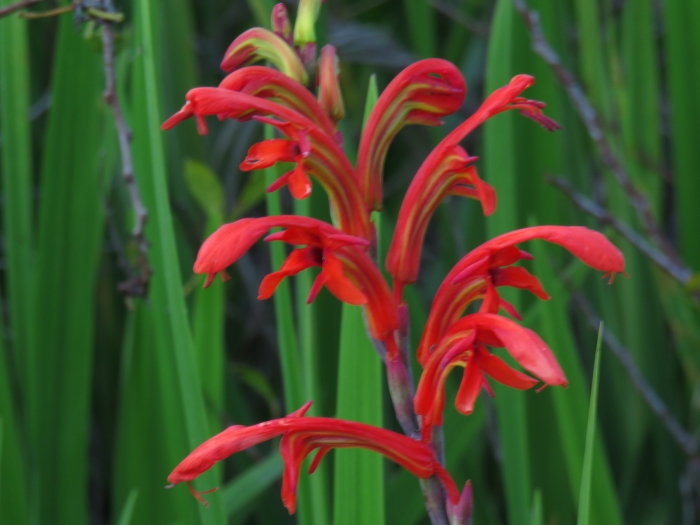Cobra Lily
(Chasmanthe aethiopica)
Cobra Lily (Chasmanthe aethiopica)
/
/

Jeremy Gilmore
CC BY 4.0
Image By:
Jeremy Gilmore
Recorded By:
Copyright:
CC BY 4.0
Copyright Notice:
Photo by: Jeremy Gilmore | License Type: CC BY 4.0 | License URL: http://creativecommons.org/licenses/by/4.0/ | Rights Holder: Jeremy Gilmore | Publisher: iNaturalist | Date Created: 2020-06-21T15:13:17-07:00 |






























































Estimated Native Range
Summary
Chasmanthe aethiopica, commonly known as Cobra Lily, is a deciduous perennial bulb native to the fynbos and grasslands of South Africa, particularly in the Western Cape. It typically grows to a height of 2 feet (0.6 meters) and can spread 1-4 feet (0.3-1.2 meters) wide. The plant features sword-shaped leaves and produces striking, tubular orange to red flowers on tall spikes during late winter to early spring, which are particularly showy and attract pollinators such as sunbirds.
Cobra Lily is valued for its vibrant, exotic-looking flowers and is often used in borders, as a focal point in gardens, or naturalized in grassy areas. It is relatively low maintenance, requiring minimal water once established, making it suitable for water-wise gardens. It thrives in well-drained soils and can tolerate a range of soil types, from sandy to loamy. While it prefers full sun to part shade, in hotter climates, some afternoon shade can be beneficial. After flowering, the foliage dies back, and the plant remains dormant until the next growing season. It is not known for serious pest or disease problems, but it can be sensitive to overly wet conditions which may cause bulb rot.CC BY-SA 4.0
Cobra Lily is valued for its vibrant, exotic-looking flowers and is often used in borders, as a focal point in gardens, or naturalized in grassy areas. It is relatively low maintenance, requiring minimal water once established, making it suitable for water-wise gardens. It thrives in well-drained soils and can tolerate a range of soil types, from sandy to loamy. While it prefers full sun to part shade, in hotter climates, some afternoon shade can be beneficial. After flowering, the foliage dies back, and the plant remains dormant until the next growing season. It is not known for serious pest or disease problems, but it can be sensitive to overly wet conditions which may cause bulb rot.CC BY-SA 4.0
Plant Description
- Plant Type: Bulb
- Height: 1.5-2 feet
- Width: 1-4 feet
- Growth Rate: Moderate
- Flower Color: Orange
- Flowering Season: Spring, Summer
- Leaf Retention: Deciduous
Growth Requirements
- Sun: Full Sun, Part Shade
- Water: Medium, High
- Drainage: Medium, Fast
Common Uses
Drought Tolerant, Low Maintenance, Showy Flowers
Natural Habitat
Fynbos and grasslands of South Africa, particularly in the Western Cape
Other Names
Common Names: Adam’S Rib
Scientific Names: , Chasmanthe aethiopica, Antholyza aethiopica, Antholyza immarginata, Chasmanthe peglerae, Chasmanthe vittigera, Antholyza aethiopica var. immarginata, Antholyza aethiopica var. ringens, Antholyza aethiopica var. vittigera, Antholyza ringens
GBIF Accepted Name: Chasmanthe aethiopica (L.) N.E.Br.